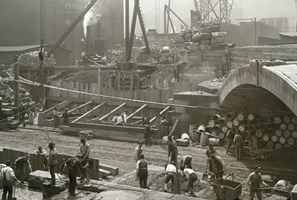 Railroad bridge construction 1903, Carnegie Museum of Art |
In grade school we learned that Samuel Slater's textile mill launched our industrial revolution and that the Civil War created the demand for coal, iron, and steampower that fueled it. We also learned that an expanding railroad system in the 1850s paved the way for a national economy and that the "age of electricity" -- the invention of the telegraph in 1844, the telephone in 1876, arc lamps and dynamos in 1878, and the incandescent lamp in 1879 -- not only revolutionized communications, but ultimately made large-scale manufacturing possible. These inventions and |
improvements spurred economic growth and transformed the United States from an agricultural country in 1850 to an industrial powerhouse by 1900 -- a story that is well- known and well-documented. But what about the "working stiffs" who made this transformation possible: The coal and iron miners who produced the raw materials that fueled economic growth? The construction workers who built the railroads, bridges, mills and manufactories? The electrical linemen who traveled wherever the industry beckoned to erect utility poles, string "hot" power lines, and electrify the country? How did they experience this era of remarkable growth? What did industrialization mean to the men, women and children who built America? And how did they respond to social and economic changes that altered their everyday lives -- sometimes for better and sometimes for worse? "What Did Labor Want?" doesn't have all the answers -- but it does offer a range of primary sources that opens a window on working-class life and the reasons why labor organized. To learn more, return to what's inside and begin investigating. |